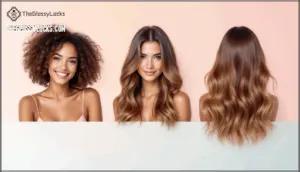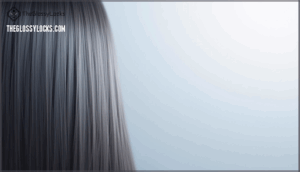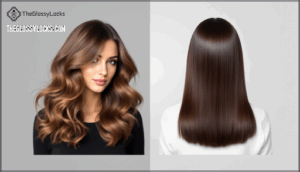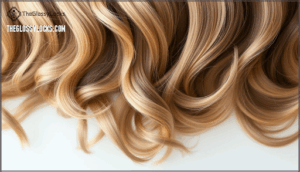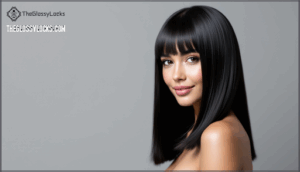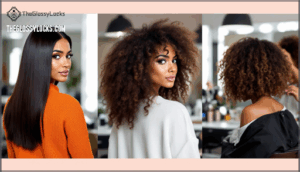This site is supported by our readers. We may earn a commission, at no cost to you, if you purchase through links.
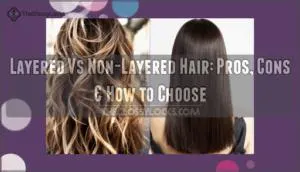 Your hair frames your face every single day, but the way it’s cut determines whether it falls flat or comes alive with movement. Layered cuts stack different lengths to create dimension and lift, while non-layered hair maintains one uniform length for a sleek, polished edge.
Your hair frames your face every single day, but the way it’s cut determines whether it falls flat or comes alive with movement. Layered cuts stack different lengths to create dimension and lift, while non-layered hair maintains one uniform length for a sleek, polished edge.
The difference isn’t just cosmetic—it changes how your hair behaves, how much time you’ll spend styling it, and whether it flatters your face shape. Understanding what sets these two approaches apart helps you choose the cut that matches your hair texture, lifestyle, and the look you’re actually after.
Table Of Contents
- Key Takeaways
- What is Layered Vs Non-Layered Hair?
- Benefits of Layered Haircuts
- Drawbacks of Layered Haircuts
- Pros and Cons of Non-Layered Hair
- How to Choose The Right Style
- Frequently Asked Questions (FAQs)
- What are the different types of layers?
- How do I know if layered hair is right for me?
- How do I style layered hair?
- How often do I need to get my layered hair trimmed?
- What are the best products for layered hair?
- Can layered hair work with very short styles?
- How do layers affect hair color and highlights?
- Can you transition from layered to non-layered hair?
- Do layers damage hair more than blunt cuts?
- Conclusion
Key Takeaways
- Layered cuts remove 18-22% of bulk and create up to 30% more visual volume by stacking different lengths, which makes hair bounce and move naturally instead of hanging flat.
- Non-layered hair maintains one uniform blunt edge that creates a sleek, polished look with simpler maintenance—requiring trims only every 10-12 weeks versus the 6-8 weeks layered cuts demand.
- Your hair texture and density determine which cut works best: thick or wavy hair benefits most from layers that reduce weight, while fine hair can look sparse with too much layering but gains thickness from blunt cuts.
- Face shape plays a major role in whether layers will flatter you—round faces need long layers for length, square faces require soft curves to soften angles, and heart-shaped faces benefit from chin-length layers that add jaw width.
What is Layered Vs Non-Layered Hair?
When you’re deciding between layered and non-layered hair, you need to understand what each style actually means.
The cut structure determines how your hair moves, how much volume it has, and how it frames your face.
Let’s break down the definitions and visual differences between these two approaches.
Definition of Layered Hair
Layered hair is cut at different lengths throughout, creating a stacked effect that adds dimension and shape to your style. Think of it like a deck of cards—each section sits at a different length, with the shortest layers generally starting near your crown and the longest reaching your mid-back or beyond. This cutting technique removes weight and creates movement, which is why layered styles are so popular for adding hair volume.
| Layer Type | Length Pattern | Best For |
|---|---|---|
| Short layers | Crown to ear level | Fine, flat hair |
| Medium layers | Ear to shoulder | Most hair types |
| Long layers | Below shoulder | Thick, heavy hair |
Definition of Non-Layered Hair
Non-layered hair, on the other hand, is cut to one uniform length all the way around, creating a blunt edge with no variation in how the strands fall. This solid form maintains even texture and uniform density from roots to ends. You won’t see any stacked effect—just one clean line that creates a sleek, polished look. Non-layered hair keeps all the weight at the bottom, which works well if you want fullness without movement.
| Nonlayered Hair Pros and Cons | Details |
|---|---|
| Definition | Hair cut to one length with blunt cut edges |
| Appearance | Sleek, uniform, polished |
| Weight Distribution | Heavy at ends, full density |
| Best For | Fine hair needing thickness, low-maintenance styles |
Key Visual Differences
When you put these cuts side by side, the differences jump out. Layered haircuts visually boost hair volume by up to 30% because they remove bulk and create movement—your hair bounces instead of just hanging. Non-layered hair reflects light uniformly, giving you that sleek, polished edge.
Layered styles show texture variations and shape contrast, while non-layered hair keeps everything flat and even. It’s like comparing a deck of cards fanned out versus stacked neatly in a pile. Layered hair is especially popular because it can frame the face and add definition.
| Feature | Layered Hair | Non-Layered Hair |
|---|---|---|
| Volume | 30% more visual lift | Flat, uniform silhouette |
| Movement | Energetic, bouncy | Minimal to none |
| Light Reflection | Multi-angle, adds density | Uniform, sleek finish |
| Texture | Three-dimensional, airy | Smooth, one-level |
Benefits of Layered Haircuts
Layered haircuts aren’t just about aesthetics—they’re a major benefit for your hair’s overall look and feel. Whether you’re working with fine strands that need a boost or trying to frame your face in the most flattering way, layers offer real solutions.
Let’s break down the key benefits that make layered cuts the top choice for 27% of women today.
Adds Volume and Movement
If your hair feels flat or lifeless, layers work like a magic trick that brings dimension back to every strand. Layered haircuts vs non-layered options create bounce and fullness by removing weight. This dimensional layering lets hair move naturally instead of hanging heavy. Fine hair volume improves dramatically, while curly hair movement becomes more defined. The layered texture boost gives you that salon-fresh look.
- Adds instant volume – Layers lift roots and create space between strands
- Elevates natural hair movement – Each layer catches light differently for flow
- Boosts texture and body – Works especially well for fine hair needing fullness
- Creates dimensional depth – Multiple levels prevent that flat, one-length appearance
Enhances Face Shape and Features
When you look in the mirror, the right layers frame your face like a custom portrait—softening angles, highlighting cheekbones, and drawing attention exactly where you want it. Face-framing pieces balance proportions by adding width to narrow faces or slimming rounder ones.
Layering for angles softens harsh lines, while highlighting bone structure brings out your best features. Hair texture and face shape work together when layers flatter what makes you uniquely you.
Versatility for Different Hair Types
Layered haircuts work with practically any hair texture—straight, wavy, or curly—giving you flexibility most other styles can’t match. They boost volume in fine hair by about 40% and reduce bulk in thick strands, improving manageability by 55%. For curly types, layers enhance curl definition and create silhouette balance without excess weight.
This texture adaptability explains why over 72% of stylists recommend layers for movement and depth, making layered haircuts vs non layered an easy choice for diverse hair types. Layered hair is also known to accentuate facial features (https://www.lordhair.com/blog/layers-vs-non-layered-hair), further highlighting a person’s style.
Drawbacks of Layered Haircuts
Layered haircuts aren’t all sunshine and good hair days. While they work wonders for volume and movement, they come with their own set of challenges that you should consider before committing.
Let’s look at the practical downsides that might affect your daily routine and long-term hair goals.
High Maintenance and Upkeep
Think of layered hair like a high-performance sports car—it looks stunning, but you’ll need to commit to regular tune-ups to keep it running smoothly. Maintaining layered hair demands more attention than you might expect:
- Salon visits every 6-8 weeks to prevent awkward grow-out phases
- Daily styling time increases with heat tools and product usage
- Specialized products for texture, volume, and damage control
- Frequent trimming to keep layers defined and prevent split ends
This ongoing hair maintenance makes layered hair pros and cons worth weighing carefully before you commit.
Styling Challenges
Ever tried to pull your hair back into a sleek ponytail, only to discover a few dozen rebellious layers sticking out like tiny protest signs? That’s the reality of styling layered hair.
You’ll face hairstyle limitations with updos and braids, plus increased styling time using hair styling products to blend shorter pieces. Texture matching becomes tricky—longer layers want to behave differently than shorter ones.
Mastering styling techniques for layered hair takes practice, patience, and the right hair styling tips to tame those unruly ends.
Difficulties With Hair Growth and Regrowth
Growing out layers feels like watching different parts of your hair run a marathon at completely different speeds—and they never cross the finish line together. Hair growth and layers don’t mix well during the awkward phase.
You’ll battle uneven layer growth and layer regrowth challenges as shorter pieces struggle to catch up. Post-cut hair health suffers from layered hair breakage at different lengths, limiting regrowth styling options while you wait for hair growth and care routines to bring everything back into balance.
Pros and Cons of Non-Layered Hair
Non-layered hair offers a different set of advantages and challenges compared to its layered counterpart. This style creates a uniform, blunt cut that appeals to those who want simplicity and polish.
Let’s look at what you gain—and what you give up—when you skip the layers.
Sleek and Tidy Appearance
Non-layered hair gives you that polished, uniform look where every strand falls to the same length like a sharp, clean edge. This sleek style works beautifully for professional settings and formal events where you want a refined appearance.
The blunt cut creates structure that’s ideal for hair styling without complicated layered hair techniques. It’s one of those haircut styles that naturally looks put-together with minimal effort.
Simple Maintenance Routine
One of the biggest perks of going non-layered is how much time you’ll save when you’re getting ready each day. Your hair care routines become straightforward because you don’t need multiple styling products to control different lengths. Here’s what makes daily care easier:
- Product selection stays simple—basic shampoo and conditioner take care of everything
- Trim frequency drops to every 10-12 weeks instead of constant touch-ups
- Damage prevention comes naturally since blunt ends protect against split ends better
Your hair maintenance tips shrink down to the basics, and home remedies work faster on uniform lengths.
Limited Styling Flexibility
While non-layered hair keeps things simple, it won’t give you the same range of options when you want to switch up your look. Styling limitations show up fast—you can’t create dimension without natural movement.
Updo challenges and braid difficulty increase because uniform length lacks the grip that layered haircuts provide.
Your hairstyle variety shrinks since hair styling techniques need different lengths to work their magic.
How to Choose The Right Style
Choosing between layered and non-layered hair isn’t one-size-fits-all. Your hair’s natural texture, your face shape, and how much time you’re willing to spend on styling all play a role.
Let’s break down what you need to think about before making the cut.
Assessing Hair Texture and Density
Before you commit to layers or a blunt cut, you need to understand your hair texture and type. Hair texture ranges from straight (Type 1) to coily (Type 4), and density is measured by strand count per square inch—usually 800 to 1,290 hairs.
Check your ponytail circumference: less than 2 inches means low density, while over 4 inches signals high density.
Thick, high-density hair benefits from layering that removes 18-22% of bulk, while thin hair needs careful layering to avoid looking sparse.
Face Shape Considerations
Once you’ve nailed down your texture and density, your face shape becomes the deciding factor in whether layers will flatter or fall flat. Face shapes and layering work together like puzzle pieces—get it right, and your facial features shine.
- Round faces: Long layers slim the face and add length
- Square faces: Soft, curved layers soften angular jawlines
- Oval faces: Nearly any layering style complements this balanced shape
- Heart faces: Chin-length layers add width at the jaw
- Diamond faces: Face-framing layers balance wider cheekbones
Your face shape and haircuts should work together, not against each other.
Lifestyle and Maintenance Needs
Before you book that appointment, think about how much time you’re willing to spend with a blow dryer in your hand each morning. Layered cuts demand more time investment with daily styling and regular hair trims every 6-8 weeks. You’ll need styling product usage to keep layers in place and manage that extended growout time.
Non-layered hair offers simpler hair care and upkeep, fewer salon visit frequency requirements, and minimal daily routine impact—perfect if you’re short on time.
Frequently Asked Questions (FAQs)
What are the different types of layers?
Layers are like building blocks—each one stacks to create dimension. Classic layers start shorter at the crown and gradually lengthen. Multi-layer cuts add more stacked sections for texture.
Invisible layers blend seamlessly without obvious separation. Face-framing layers contour your features, while graduated layers create stacked volume.
How do I know if layered hair is right for me?
Your hair texture, face shape, and lifestyle fit determine if layers work for you. Layers accentuate facial features but require upkeep—thick or wavy hair benefits most from layering.
Consider your maintenance commitment and styling skills before choosing a hairstyle.
How do I style layered hair?
Think of styling layered hair like painting—you need the right tools and products. Apply lightweight mousse to damp hair, then use a heat protectant before blow-drying with a diffuser.
Work texturizing paste through the ends for definition, and curl face-framing layers with a flat iron for movement.
How often do I need to get my layered hair trimmed?
You’ll want to book salon visits every 6-8 weeks for haircut maintenance and styling. Regular trim frequency prevents split ends and keeps layers looking fresh.
Your hair growth rate affects how quickly layers lose their shape, so consistent hair care and upkeep guarantees your hair refresh stays polished.
What are the best products for layered hair?
You’d think magic pixie dust keeps layers looking sharp, but it’s actually volumizing products and smoothing frizz serums.
Use lightweight mousse for defining curls, texturizing paste for protecting layers, and leave-in conditioner for maintaining moisture throughout your hair.
Can layered hair work with very short styles?
Yes, short layered haircuts work beautifully. Layered pixie haircuts and layered bobs add volume boost and styling options. Short hair benefits from layers that create texture and movement.
Maintenance ease varies, but regular trims keep your style fresh.
How do layers affect hair color and highlights?
Like a prism catching sunlight, layers work as a canvas for hair color and highlights. They create color dimension through strategic highlight placement, making tones pop with depth.
Blending layers with layered balayage techniques adds natural contrast, though color upkeep increases since hair texture and layering require more frequent touch-ups to maintain vibrancy.
Can you transition from layered to non-layered hair?
Adjusting back takes patience. You’ll need to let shorter layers grow out while maintaining hair health with regular trims.
Blending layers during haircut appointments helps create a more even hair length over time, though full grow-out strategies require commitment.
Do layers damage hair more than blunt cuts?
You might assume cutting techniques affect hair health, but they don’t. Layered hair breakage happens from haircut maintenance tips being ignored—trimming frequency matters more than your cut style.
Both layered haircuts and blunt cut dryness stem from product buildup and poor hair care and upkeep, not the shears.
Conclusion
Nearly 65% of salon clients request layered cuts specifically for added volume—a clear indication of how much structure shapes perception. Layers breathe life into flat hair but demand consistent trims, while blunt cuts offer simplicity at the cost of movement.
Your choice between layered vs non-layered hair ultimately comes down to what you’re willing to maintain and how your natural texture cooperates. Match your decision to your daily routine, not just a Pinterest board. The right cut doesn’t fight your hair—it works with what you’ve already got.
- https://medihair.com/en/statistics-the-10-most-popular-female-hairstyles/
- https://www.fabulive.com/blogs/news/layered-hair-the-subtle-trend-that-adds-volume-amp-movement
- https://www.glamour.com/gallery/most-popular-haircuts
- https://fivestarbarberbrand.com/2025/09/05/layered-haircuts-vs-non-layered/
- https://www.allthingshair.com/en-us/haircuts/haircut-facts/

